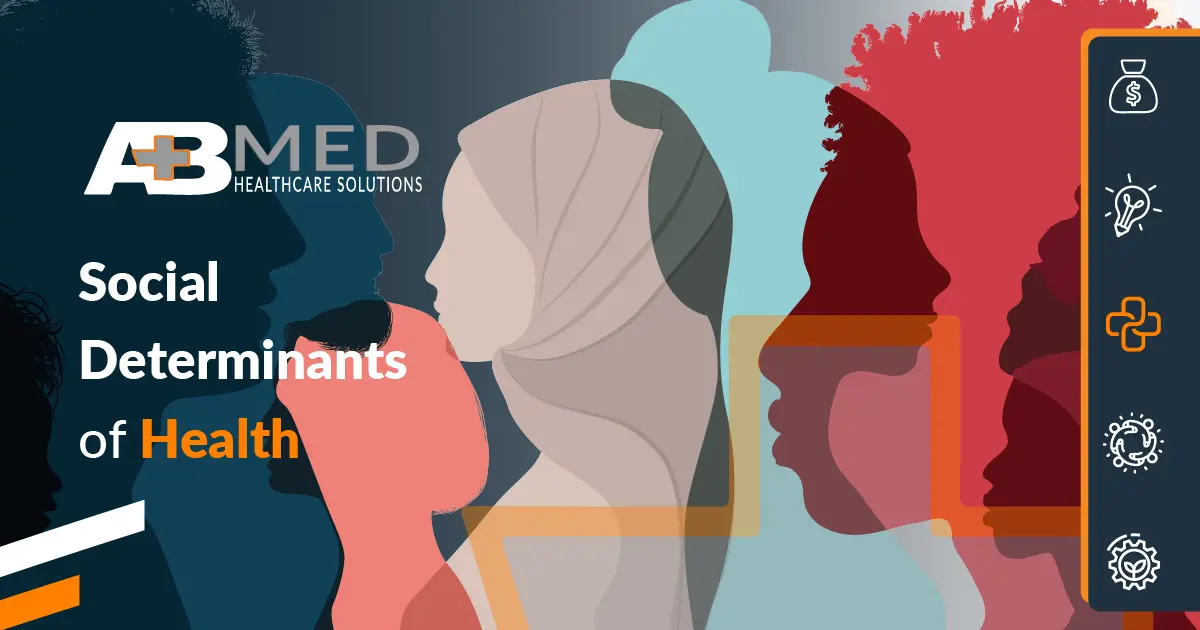There are a variety of different factors—including nonmedical ones—that influence a person’s health risks and ultimate health outcomes. The U.S. Department of Health and Human Services’ Healthy People 2030 framework describes these different elements as social determinants of health (SDOH) and classifies them into five distinct categories. (i)
Social determinants of health are the “conditions and environments in which people are born, live, learn, work, play, worship, and age.” (ii) For public health initiatives to be most effective, all these conditions must be considered, weighed, and addressed by community and health leaders. The five social determinants of health domains are:
Health care leaders should recognize that the disparities between these conditions put certain communities at risk. (ii) In this article, we will outline each of the different social determinants of health domains, provide examples of their adverse effects on health outcomes, and offer insight into how to develop programs that address these health inequities
Economic Stability
A person’s economic status can dramatically affect their health behaviors and risk for developing disease. The less financial stability an individual has, the more limited their opportunities will likely be for prioritizing and protecting their health.
For example, unemployment can have serious health consequences. (iii) Securing health insurance can be financially prohibitive without full-time employment. And even then, many lower-paying jobs do not offer any health benefits or paid sick leave necessary to seek medical care.
Other underlying economic factors that can contribute to negative health outcomes include: (iv)
- Food Insecurity
- Housing Stability
- Poverty
Public health efforts should take all these financial considerations into account when strategizing ways to decrease health risks in low-income communities.

-
Education
Another significant social determinant of health closely related to economic stability is education.
One example of an educational barrier that can impact health outcomes is limited English proficiency and literacy. (v) It is much more difficult to navigate health care services or to even advocate for yourself as a patient when you have difficulty communicating with those in the health field. In fact, individuals with limited English proficiency report lower self-rated health than those whose only language is English. (v)
Other educational barriers could involve: (iv)
- Early Childhood Education and Development
- Enrollment in Higher Education
- High School Graduation
Education, in many ways, dictates the type of opportunities available to an individual, including how well they can care for their health. According to a report published by the NCBI, programs that close these educational gaps are necessary to promote health equity. (vi)
-
Social and Community Context
A person’s community context and social environment can also substantially impact their health.
According to the Office of Disease Prevention and Health Promotion, “When compared to the general population, men and women with a history of incarceration are in worse mental and physical health.” (vii) Communities with high rates of incarceration also suffer from multigenerational effects: “children of incarcerated parents often have higher rates of learning disabilities, developmental delays, speech/language problems, attention disorders, and aggressive behaviors…children of incarcerated parents have been found to be up to 5 times more likely to enter the criminal justice system than children of non–incarcerated parents.” (vii)
Incarceration is just one example of how one’s social environment in which they are raised can have dramatic effects on their life and their health specifically.
Other community context elements that can influence health outcomes are: (iv)
- Civic Participation
- Discrimination
- Social Cohesion
Education, in many ways, dictates the type of opportunities available to an individual, including how well they can care for their health. According to a report published by the NCBI, programs that close these educational gaps are necessary to promote health equity. (vi)
-
Health and Health Care
Despite the strong association between access to primary care and favorable health outcomes, some communities still face obstacles that make it difficult to receive care. (viii)
Transportation-related barriers, a shortage in care providers, and the inability to take off work are just a few of the many disparities related to primary care access. (viii) Another limiting factor could be poor health literacy in general. (iv) It is difficult for public health programs and initiatives to be effective if the audience they are aimed at doesn’t correctly understand their risks and what they can be doing to prevent them. It is not enough for health care resources to be available; individuals must understand how to access and interpret those resources as well.
-
Neighborhood and Built Environment
Finally, the environment in which an individual lives plays a significant role in their health opportunities and barriers. A powerful example of this concept is food deserts.
According to a report published by the NCBI, food deserts exist especially in lower-income, inner-city, and rural areas with very limited access to healthy foods like fruits and vegetables. (ix) These food deserts are often the same areas with “high rates of obesity and chronic, diet-related diseases.” (ix)
Other elements of “place” that can substantially impact health outcomes are: (iv)
- Crime and Violence
- Environmental Conditions
- Quality of Housing
All these location-specific factors need to be considered and addressed within successful public health programs.
Using SDOHs as a Framework for Public Health Initiatives
A broad perspective on all the different social determinants of health domains is necessary to develop effective public health initiatives. Public health leaders should look beyond singular health issues and instead view community health obstacles with a wider lens that takes a variety of barriers and limitations into account.
At AB Med, we provide innovative health care solutions for your community’s needs. We can help you develop, launch, and manage public health programs that address the social determinants of health most relevant to your needs. We would love to partner with you to keep your community healthy through strategic, expert-backed initiatives and health care problem-solving.
REFERENCES & RESOURCES
- Office of Disease Prevention and Health Promotion (n.d.). Social Determinants of Health – Healthy People 2030 | health.gov. [online] health.gov. Available at: https://health.gov/healthypeople/priority-areas/social-determinants-health.
- health.gov. (n.d.). Social Determinants of Health Workgroup – Healthy People 2030 | health.gov. [online] Available at: https://health.gov/healthypeople/about/workgroups/social-determinants-health-workgroup.
- Healthypeople.gov. (2014). Employment | Healthy People 2020. [online] Available at: https://www.healthypeople.gov/2020/topics-objectives/topic/social-determinants-health/interventions-resources/employment.
- Healthy people (2020). Social determinants of health. [online] Healthypeople.gov. Available at: https://www.healthypeople.gov/2020/topics-objectives/topic/social-determinants-of-health.
- Healthypeople.gov. (2014). Language and Literacy | Healthy People 2020. [online] Available at: https://www.healthypeople.gov/2020/topics-objectives/topic/social-determinants-health/interventions-resources/language-and-literacy.
- Hahn, R.A. and Truman, B.I. (2015). Education Improves Public Health and Promotes Health Equity. International Journal of Health Services, [online] 45(4), pp.657–678. Available at: https://www.ncbi.nlm.nih.gov/pmc/articles/PMC4691207/.
- Office of Disease Prevention and Health Promotion (2014). Incarceration | Healthy People 2020. [online] Healthypeople.gov. Available at: https://www.healthypeople.gov/2020/topics-objectives/topic/social-determinants-health/interventions-resources/incarceration.
- Healthypeople.gov. (2014). Access to Primary Care | Healthy People 2020. [online] Available at: https://www.healthypeople.gov/2020/topics-objectives/topic/social-determinants-health/interventions-resources/access-to-primary
- National Research Council (US (2009). Summary. [online] Nih.gov. Available at: https://www.ncbi.nlm.nih.gov/books/NBK208018/.






